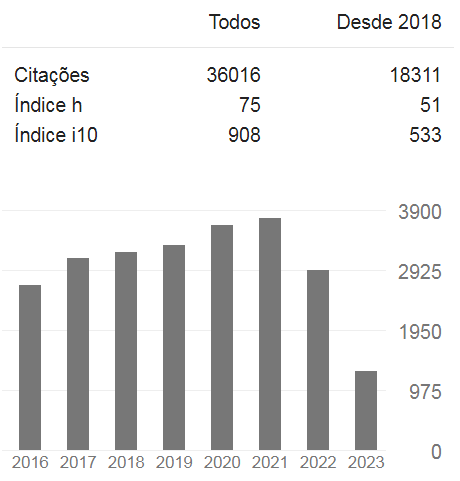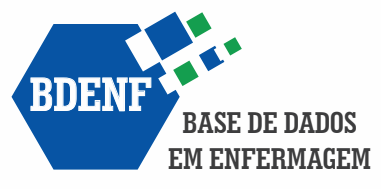Nurses' opinion on risk classification in emergency services
DOI:
https://doi.org/10.5935/1415-2762.20170072Keywords:
Nursing Assessment, User Embracement, TriageAbstract
The aim of risk classification in emergency services is to prioritize care, considering the severity of the patient's clinical condition. However, nurses face difficulties in the development of this activity. The study aims to evaluate the opinion of nurses on risk classification in emergency services. This is a descriptive, quantitative study, using the Delphi technique. Three rounds of opinions were collected by means of a questionnaire provided through an electronic platform. Response alternatives were presented in a Likert-type scale and consensus was achieved when the frequency of the percentage of response alternatives was greater than or equal to 70%. The study sample included nurses with professional experience and/or researchers in the studied field. The first round had the participation of 130 nurses, the second 89, and the third 65 nurses. The nurses mentioned that risk classification organizes the flow of patients and reduces the waiting time for severe patients to be assisted. In this process, they use clinical knowledge, professional experience and the ability to manage conflicts. Nurses disagreed that risk classification provides hosting and privacy to patients, and that there is periodical training available for exercising this activity. In conclusion, patients' risk classification strengthens the nurses' care practice; however, strategies must be created to overcome structural difficulties.
References
Carter EJ, Pouch SM, Larson EL. The relationship between emergency department crowding and patient outcomes: a systematic review. J Nurs Scholarsh. 2014 [citado em 2017 ago. 20]; 46(2):106-15. Disponível em: 10.1111/jnu.12055. Epub 2013 Dec 19.
Ministério da Saúde (BR). Secretaria-Executiva. Humaniza SUS: Política Nacional de Humanização: a humanização como eixo norteador das práticas de atenção e gestão em todas as instâncias do SUS. Brasília: MS; 2009. [citado em 2017 maio 08]. Disponível em: http://bvsms.saude.gov.br/bvs/publicacoes/humanizasus_2004.pdf.
Souza CC, Diniz AS, Silva LLT, Mata LRF, Chianca TCM. Nurses' perception about risk classification in an emergency service. Invest Educ Enferm. 2014[citado em 2017 maio 03];32(1):78-86. Disponível em: http://www.scielo.org.co/scielo.php? script=sci_abstract&pid=S0120- 53072014000100009&lng=en&nrm=iso&tlng=es
Susan E, Domagala J, Vets BSN. Emergency nursing triage: keeping it safe. J Emerg Nurs. 2015[citado em 2017 ago. 20]; 41(4):313-6. Disponível em: 10.1016/j.jen.2015.01.022. Epub 2015 Mar 17.
Shuetz P, Hausfater P, Amin D, Haubitz S, Fässler L, Grolimund E, et al. Optimizing triage and hospitalization in adult general medical emergency patients: the triage Project. BMC Emerg Med. 2013[citado em 2017 maio 01];13:12. Disponível em: https://www.ncbi.nlm.nih.gov/pmc/articles/PMC3723418/pdf/1471-227X-13-12.pdf.
Acosta AM, Duro CLM, Lima MADS. Atividades do enfermeiro nos sistemas de triagem/classificação de risco nos serviços de urgência: revisão integrativa. Rev Gaúcha Enferm. 2012[citado em 2017 maio 03];33(4):181- 90. Disponível em: http://www.scielo.br/pdf/rgenf/v33n4/23.pdf. DOI:10.1590/S1983-14472012000400023
Júnior JAB, Matsuda LM, Marcon SS. Análise do fluxo de atendimento de serviço hospitalar de emergência: estudo de caso. Rev Eletrônica Enferm. [Internet].2015 jan./mar.[citado em 2017 maio 03];17(1):108-16. Disponível em: http://dx.doi.org/10.5216/ree.v17i1.23823. DOI: 10.5216/ree.v17i1.23823.
Reay G, Rankin JA, Then KL. Momentary fitting in a fluid environment: a grounded theory of triage nurse decision makin. Int Emerg Nurs. 2016[citado em 2017 abr. 15];26:8-13. Disponível em: http://ac.elscdn.com/S1755599X15001184/1-s2.0-S1755599X15001184-main.pdf?_tid=90983fb4-3646-11e7-83c600000aab0f6c&acdnat=1494506416_1402d11242d90293f 74cf299ab7f035a.
Inoue KC, Bellucci Júnior JA, Papa MA, Vidor RC, Matsuda LM. Avaliação da qualidade da Classificação de Risco nos Serviços de Emergência. Acta Paul Enferm. 2015[citado em 2017 maio 09];28(5):420-5.Disponível em: http://www.scielo.br/pdf/ape/v28n5/1982-0194-ape-28-05-0420.pdf
Guedes HM, Martins JCA, Chianca TCM. Valor de predição do Sistema de Triagem de Manchester: avaliação dos desfechos clínicos de pacientes. Rev Bras Enferm. 2015[citado em 2017 abr. 05];68(1):45-51. Disponível em: http://www.scielo.br/pdf/reben/v68n1/0034-7167-reben-68-01-0045.pdf.
Hsu CC, Sandford BA. The Delphi Technique: making sense of consensus. Pract Assess Res Eval. 2007[citado em 2017 maio 01];12(10):1-10. Disponível em: http://pareonline.net/pdf/v12n10.pdf
Scarparo AF, Laus AM, Azevedo ALCS, Freitas MRI, Gabriel CS, Chaves LDP. Reflexões sobre o uso da técnica Delphi em pesquisas na enfermagem. Rev Rene. 2012[citado em 2017 ago. 20];13(1):242-51. Disponível em: http://www.revistarene.ufc.br/revista/index.php/revista/article/download/36/31
Sadler GR, Lee HC, Lim RSH, Fullerton J. Recruitment of hard-to-reach population subgroups via adaptations of the snowball sampling strategy. Nurs Health Sci. 2010[citado em 2017 abr. 05];12(3):369-74. Disponível em: https://www.ncbi.nlm.nih.gov/pmc/articles/PMC3222300/pdf/nihms-226073.pdf.
Stover-Baker B, Stahlman B, Pollack M. Triage nurse prediction of hospital admission. J Emerg Nurs. 2012[citado em 2017 ago. 20];38(3):306-10. Disponível em: 10.1016/j.jen.2011.10.003.
Coutinho AAP, Cecílio LCO, Mota JAC. Classificação de risco em serviços de emergência: uma discussão da literatura sobre o Sistema de Triagem de Manchester. Rev Med Minas Gerais. 2012[citado em 2017 ago. 20];22(2):188-98. Disponível em: http://rmmg.org/artigo/detalhes/101
KKS, Montezeli JH, Peres AM. Embracement with risk classification: opinion of the nurses at an emergency service. Rev Rene. 2012[citado em 2017 maio 03];13(4): 899-908. Disponível em: http://www.redalyc.org/pdf/3240/324027983020.pdf
Wolf L. An integrated, ethically driven environmental model of clinical decision making in emergency settings. Int J Nurs Knowl. 2013[citado em 2017 ago. 20];24(1):49-53. Disponível em: 10.1111/j.2047-3095.2012.01229.x
Noon AJ. The cognitive processes underpinning clinical decision in triage assessment: a theoretical conundrum? Inter Emerg Nurs. 2014[citado em 2017 ago. 20]; 22:40-6. Disponível em: https://www.ncbi.nlm.nih.gov/pubmed/23685041
Ek B, Svedlund M. Registered nurses' experiences of their decision‐making at an Emergency Medical Dispatch Centre. J Clin Nurs. 2015[citado em 2017 ago. 20];24(7-8):1122-31. Disponível em: 10.1111/jocn.12701
Forsman B, Forsgren S, Carlström ED. Nurses working with Manchester triage: the impact of experience on patient security. Australas Emerg Nurs J. 2012[citado em 2017 ago. 20];15(2):100-7. Disponível em: https://doi.org/10.1016/j.aenj.2012.02.001
Hitchcock M, Gillespie B, Crilly J, Chaboyer W. Triage: an investigation of the process and potential vulnerabilities. J Adv Nurs. 2013[citado em 2017 ago. 20]; 70(7):1532-41. Disponível em: 10.1111/jan.12304
Angland S, Dowling M, Casey D. Nurses' perceptions of the factors which cause violence and aggression in the emergency department: a qualitative study. Int Emerg Nurs. 2014[citado em 2017 ago. 20];22(3):134-9. Disponível em: https://doi.org/10.1016/j.ienj.2013.09.005
Guedes MVC, Henriques ACPT, Lima MMN. Acolhimento em um serviço de emergência: percepção dos usuários. Rev Bras Enferm. 2013[citado em 2017 maio 03];66(1):31-7. Disponível em: http://www.scielo.br/pdf/reben/v66n1/v66n1a05.pdf
Vituri DW, Inoue KC, Bellucci JAJ, Oliveira CA, Rossi RM, Matsuda LM. Welcoming with risk classification in teaching hospitals: assessment of structure, process and result. Rev Latino-Am Enferm. 2013[citado em 2016 abr. 30]; 21(5):1179-87. Disponível em: http://www.revistas.usp.br/rlae/article/view/76038/79700.
Dateo J. What factors increase the accuracy and inter-rater reliability of the emergency severity index among emergency nurses in triaging adult patients? J Emerg Nurs. 2013[citado em 2017 ago. 20];39(2):203-7. Disponível em: https://www.ncbi.nlm.nih.gov/pubmed/22079643
Downloads
Published
Issue
Section
License
Copyright (c) 2018 Reme: Revista Mineira de Enfermagem

This work is licensed under a Creative Commons Attribution 4.0 International License.






































